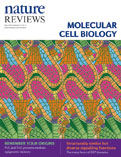|
| TABLE OF CONTENTS | |||||||||||||||||||||||||||||||||||||||||||||||
| May 2014 Volume 15 Number 5 | Advertisement | ||||||||||||||||||||||||||||||||||||||||||||||
| In this issue
|
| |||||||||||||||||||||||||||||||||||||||||||||
| |||||||||||||||||||||||||||||||||||||||||||||||
 | |||||||||||||||||||||||||||||||||||||||||||||||
| Advertisement | |||||||||||||||||||||||||||||||||||||||||||||||
| |||||||||||||||||||||||||||||||||||||||||||||||
| |||||||||||||||||||||||||||||||||||||||||||||||
| REVIEWS | Top | ||||||||||||||||||||||||||||||||||||||||||||||
| Plant and animal stem cells: similar yet different Renze Heidstra & Sabrina Sabatini p301 | doi:10.1038/nrm3790 As in animals, plant stem cells reside in stem cell niches, which produce signals that regulate the balance between self-renewal and differentiation into new tissues. Continuous organ production that is characteristic of plant growth requires a robust regulatory network to maintain this balance. Elucidating this network provides an opportunity to compare plant and animal stem cell strategies. Abstract | Full Text | PDF | |||||||||||||||||||||||||||||||||||||||||||||||
| The dynamic epitranscriptome: N6-methyladenosine and gene expression control Kate D. Meyer & Samie R. Jaffrey p313 | doi:10.1038/nrm3785 The results of transcriptome-wide N6-methyladenosine (m6A) mapping techniques have resolved many of the long-standing concerns regarding the physiological relevance of m6A, which suggests that this modification regulates mRNA fate and function. The identification of adenosine methylases and demethylases provides insights into the cellular pathways that involve m6A and indicates a role of m6A in physiological processes. Abstract | Full Text | PDF | Supplementary information | |||||||||||||||||||||||||||||||||||||||||||||||
Advances in whole-embryo imaging: a quantitative transition is underway Periklis Pantazis & Willy Supatto p327 | doi:10.1038/nrm3786 Advances over the past decade in the development of imaging probes, microscopy techniques and image analysis have enabled researchers to gain a deeper knowledge and understanding of the dynamic processes of embryonic differentiation, patterning and morphogenesis through quantitative whole-animal imaging studies with high spatiotemporal resolution. Abstract | Full Text | PDF | |||||||||||||||||||||||||||||||||||||||||||||||
| What are memories made of? How Polycomb and Trithorax proteins mediate epigenetic memory Philipp A. Steffen & Leonie Ringrose p340 | doi:10.1038/nrm3789 Epigenetic memory maintains gene expression states through cell generations, in the absence of the initiating signals or changes in DNA sequence. Our understanding of how the Polycomb (PcG) and Trithorax (TrxG) group proteins confer long-term, mitotically heritable memory by sustaining silent and active gene expression states, respectively, during DNA replication and mitosis, is increasing. Abstract | Full Text | PDF | Supplementary information | |||||||||||||||||||||||||||||||||||||||||||||||
| PERSPECTIVES | Top | ||||||||||||||||||||||||||||||||||||||||||||||
| OPINION DEP domains: structurally similar but functionally different Sarah V. Consonni, Madelon M. Maurice & Johannes L. Bos p357 | doi:10.1038/nrm3791 Dishevelled, EGL-10 and pleckstrin (DEP) domains carry out diverse functions by using different binding interfaces with well-defined structural features. It is becoming apparent that DEP domains mainly function in the spatial and temporal control of diverse signal transduction events by interacting with various partners at the plasma membrane. Abstract | Full Text | PDF | |||||||||||||||||||||||||||||||||||||||||||||||
| Advertisement | |||||||||||||||||||||||||||||||||||||||||||||||
| |||||||||||||||||||||||||||||||||||||||||||||||
| |||||||||||||||||||||||||||||||||||||||||||||||
| * 2011 Journal Citation Report (Thomson Reuters, 2013) |
You have been sent this Table of Contents Alert because you have opted in to receive it. You can change or discontinue your e-mail alerts at any time, by modifying your preferences on your nature.com account at: www.nature.com/myaccount For further technical assistance, please contact our registration department For print subscription enquiries, please contact our subscription department For other enquiries, please contact our feedback department Nature Publishing Group | 75 Varick Street, 9th Floor | New York | NY 10013-1917 | USA Nature Publishing Group's worldwide offices: Macmillan Publishers Limited is a company incorporated in England and Wales under company number 785998 and whose registered office is located at Brunel Road, Houndmills, Basingstoke, Hampshire RG21 6XS. © 2014 Nature Publishing Group, a division of Macmillan Publishers Limited. All Rights Reserved. |
 |









No comments:
Post a Comment